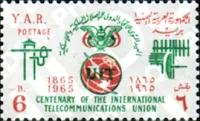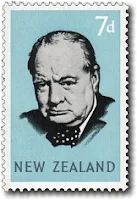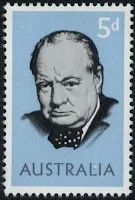It was my original intention to make this a small post featuring the four stamps from the Commemorative Issues of 1965 but other members of our blog team kept sending me interesting items which I wanted to include. Now it has grown to become quite a large post. But isn't that what the blog is about, finding something new or interesting in these often overlooked and unloved stamps. ( Anne)
1965 International Telecommunications Union Centenary.
New Zealand, in common with other members of the International Telecommunication Union, issued a special stamp in 1965 to commemorate the centenary of the organisation. The Union, which has its headquarters in Geneva, was formed in 1865 and is the oldest of the international organisations which are now specialised agencies under the United Nations. The purpose of the Union is to maintain and extend international co-operation in the use of telecommunications of all kinds.
9d - International Telecommunications Union (ITU).
The design shows a telegraph wire held by a post from 1865 on the left-hand side, while modern telecommunications from 1965 is shown on the right-hand side. In the centre is a globe show ITU as a global organisation.
The Administrative Council of the Union asked associated countries to produce a common symbolic design and a globe and telecommunication symbols were decided upon. The date of issue in New Zealand and most other countries was 17 May 1965, although Great Britain issued their stamp on 15 November and Jamaica on 29 December. Not all countries used this common design but rather doing something themselves.
 International Telecommunication Union - First Day Cover.
International Telecommunication Union stamps
from some other countries.
International Telecommunication Union - First Day Cover.
International Telecommunication Union stamps
from some other countries.
BRAZIL. 1965. CYPRUS. 1965. GHANA. 1965.
LUXEMBOURG. 1965. SPAIN. 1965. YEMEN Arab Republic. 1965.
1965 Sir Winston Churchill - Commonwealth Day.
A successful joint venture by the Australian and New Zealand postal administrations produced stamps in honour of the British statesman Sir Winston Churchill. New Zealand readily agreed to the suggestion of the Australian Post Office that commemorative stamps with a common design be prepared for issue on Commonwealth Day, 24 May 1965. The design was based on the photographic study of Churchill done in 1941 by Yousuf Karsh of Ottawa.
7d - Sir Winston Churchill. 5d - Sir Winston Churchill.
(New Zealand) (Australia)
 A First Day Cover sent to Australia. Notice the NZC Air Mail label. I enjoy looking at the hand-writing on some of these covers. My writing is terrible (lucky I have a computer), so I admire these different writing styles.
Another FDC Cover showing the colour portrait of Sir Winston Churchill used for this stamp.
This cover celebrates this joint issue with a quote from one of the most famous speeches,
given by Sir Winston Churchill, on June 4th, 1940. I thought this cover was worth including even though it goes against our policy of using addressed covers.
A First Day Cover sent to Australia. Notice the NZC Air Mail label. I enjoy looking at the hand-writing on some of these covers. My writing is terrible (lucky I have a computer), so I admire these different writing styles.
Another FDC Cover showing the colour portrait of Sir Winston Churchill used for this stamp.
This cover celebrates this joint issue with a quote from one of the most famous speeches,
given by Sir Winston Churchill, on June 4th, 1940. I thought this cover was worth including even though it goes against our policy of using addressed covers.
A home-made First Day Cover.
1965 Centenary of Government from Wellington.
4d - Wellington Provincial Council Building / Parliament.
The design was based on a watercolour painted by L B Temple in 1867 depicting the Wellington Provincial Council Building. Parliament met there from 1865 to 1873, the first session being opened on 26 July 1865. The commemorative stamp was issued a century later on 26 July 1965. The building, which was situated where the General Assembly Library now stands, was destroyed by fire in 1907.
A simple designed FDC - "100 Years of Government at Wellington - 1865 - 1965."
This is a very poor image out of the covers I had to select from but I've included it because of the information shown. What I found most interesting was the list of Capitals at the bottom-left. Not very often do you find reference to the first capital at Russell (Okiato) where Government sat for about one year in 1840, after the Treaty of Waitangi.
These two examples show the same printed cover but what is of interest to me was the different stamps used for domestic (above) and international postage (below).
1965 United Nations International Co-operation Year.
The General Assembly of the United Nations designated 1965 as International Co-operation Year. 1965 marked the 20th anniversary of the organisation, the Charter of the United Nations having been signed in June 1945.
4d - International Co-operation Year (ICY).
The Graphic Presentation Unit of the United Nations Secretariat brought out a design of clasped hands within a laurel wreath symbolising peaceful co-operation among nations. This illustration was used by many member States as the basis for their commemorative issues.
"This 4d stamp scheduled for release on 8 September was not available and for the first
time in a long while the issue was delayed until later, -- 28 September. It appears that
the reason for this delay was that stocks were late in arriving from England. The stamp
has been printed in two-colour lithography by Thomas De La Rue & Co Ltd."
Campbell Paterson Newsletter.
Vol 67 No. 3 October 2014 pg 6.
Some Errors with this Stamp.
1965 ICY 4d with doubled red, clearly obvious in New Zealand wording.
1965 ICY 4d lower selvage block of six with a major pre printing crease across lower two stamps.
1965 4d International Co-operation Year, single mint stamp with rather unusual colour variety of the background shade. This is possibly some form of proof as this colour cannot be reached by being faded to this shade.
FDC for the International Co-operation Year. 1965 issue.
ITU Technical information:-
Date of Issue:
|
17 May 1965
|
|---|
Designers:
|
M Goaman and V Whiteley, England
|
|---|
Printers:
|
Harrison and Sons, England
|
|---|
Stamp Size:
|
41mm x 25mm
|
|---|
Sheet Size:
|
120 stamps per sheet
|
|---|
Process:
|
Photogravure
|
|---|
| Perforation Gauge: |
14.75 x 14
|
|---|
Paper Type:
|
Chalk surfaced, multiple NZ and star watermark
|
|---|
Churchill Technical information:-
Date of Issue:
|
24 May 1965
|
|---|
Designers:
|
New Zealand Post Office, Wellington
|
|---|
Printers:
|
Australian Bank Note and Stamp Printer, Australia
|
|---|
Stamp Size:
|
25.5mm x 38mm
|
|---|
Sheet Size:
|
48 stamps per sheet
|
|---|
Process:
|
Photogravure
|
|---|
| Perforation Gauge: |
13.5 x 13.25
|
|---|
Paper Type:
|
Harrison and Sons, chalk surfaced, no watermark
|
|---|
Government Centenary Technical information:-
Date of Issue:
|
26 July 1965
|
|---|
Designers:
|
New Zealand Post Office, Wellington
|
|---|
Printers:
|
Harrison and Sons, England
|
|---|
Stamp Size:
|
41mm x 24.5mm
|
|---|
Sheet Size:
|
120 stamps per sheet
|
|---|
Process:
|
Photogravure
|
|---|
| Perforation Gauge: |
14.75 x 14.25
|
|---|
Paper Type:
|
Chalk surfaced, multiple NZ and star watermark
|
|---|
Co-operation Year Technical information:-
Date of Issue:
|
28 September 1965
|
|---|
Designers:
|
United Nations Organisation and Thomas De La Rue, England
|
|---|
Printers:
|
Thomas De La Rue, England
|
|---|
Stamp Size:
|
40mm x 24mm
|
|---|
Sheet Size:
|
120 stamps per sheet
|
|---|
Process:
|
Lithography
|
|---|
Performance Gauge:
|
14
|
|---|
Paper Type:
|
Multiple NZ and star watermark
|
|---|
Some of the images in this post were used with permission from the illustrated catalogue of StampsNZ
























Well done Anne. If you can interest me it must be good.
ReplyDeletePaul.
Paul the way I think it is you must be a bit interested or you would not have been reading the post to discover you were interested.
DeleteWhat I like about this blog is how you spend as much effort on unimportant stamps such as those above.
ReplyDeleteJimmy
Yes Jimmy,
DeleteThe ones you call unimportant are important too. This blog is about the design or stories behind each stamp rather than the value of it. My interest is more in the history and culture that the stamps open up since I have never collected stamps myself.
Allan's policy has always been to allow this blog to grow in whatever direction it likes. By this he means his purpose is, as Asami says above, to study the designs and other points of interest about each stamp but he will write about any stamp or issue or subject that captures his attention.
DeleteIt was never his intention to cover every issue. Since the rest of us have been helping it is now possible that we might feature every stamp. Currently we have complete everything up until 1965 and everything from 2012 to the present. Between these is a lot of stamps but there are also many that have appeared in this blog too.
Anne